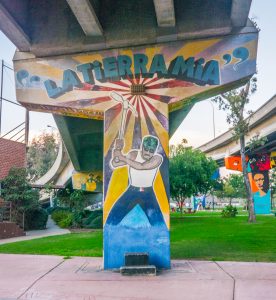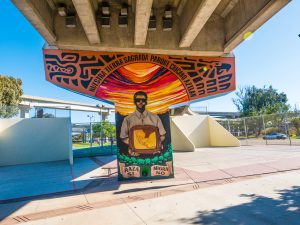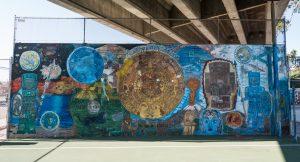Chicano Park and the Aztlán Homeland
Louis D. Gvzmann-Sivilotti
Introduction
This portfolio explores Chicano Park and the way that these murals are a representation of the Aztlán homeland that the Chicano people identify with, drawing from the work of Gloria Anzaldúa’s “Bordelands: La Frontera, the New Mestiza”.
This portfolio will explore the themes of the historical significance of Aztlán in the Chicano culture, as well as the current situation that the modern Chicano people face.



Aztlán History shown through Art
Much of the imagery in Chicano Park calls back to the historical and cultural roots of the Chicano people, which go thousands of years back to the concept of the Aztlán people. It is believed that the Aztlán people migrated from along the western coast of North America down across the Americas towards what we now call Mexico, leading to the settlement of peoples like the Aztec civilization, which created artwork and shared stories of this Aztlán migration. This gives the Chicano people a sense of belonging to the lands they now inhabit, which are now known as the Southwestern US. This is reflected in the Aztec and Indigenous imagery and motifs used in their artwork, such as the Aztec Calendar, as well as maps and landscapes of Mexico and the Southwest. The use of these artistic elements calls back to these historical roots, and is a cornerstone of the Chicano identity; in Borderlands: La Frontera, Gloria Anzaldúa describes some of the linguistic and spiritual beliefs that formed this cornerstone, like the symbolism of the sun as the spirit and father.
Aztlán Today
A large part of the Chicano identity is also formed through the history of the seizure of these lands they identify with Aztlán, as the Colonial powers arrived on the Americas and shattered the pre-existing social structures. Today, what is known to the Chicano people as Aztlán is currently under the internationally-recognized legal authority of the United States of the America, and Anzaldúa describes the history of how colonial powers eroded the Mexican people’s rights to land through violence and conflict, and how even in the 20th century there was a steady stream of legal (and illegal) seizure of land and property over time, leading to the current situation of the Chicano people being left without any real rights or ownership of their ancestral lands, like many other indigenous people. The artwork of Chicano Park symbolizes these lands and the dreams of these people who have struggled for generations against these overwhelming forces. As shown in the first artwork above, “La Tierra Mia” means “My land” or “My country”, or most relevantly, “My homeland”, and this perfectly encapsulates the Chicano belief in Aztlán in the face of modern legal boundaries and past conquests. Chicano Park stands as a unique testament to both past, present, and future, as understanding the significance of this art means understanding past conflicts, present struggles, and a hope for the future.
Media Attributions
- ‘La Tierra Mia’ mural, Chicano Park © Jay Galvin is licensed under a CC BY (Attribution) license
- Raza Si (Race yes), Migra (Migrants) No © Jay Galvin is licensed under a CC BY (Attribution) license
- Chicano Park, Azteca Calendar and Symbols Mural © Jay Galvin is licensed under a CC BY (Attribution) license
